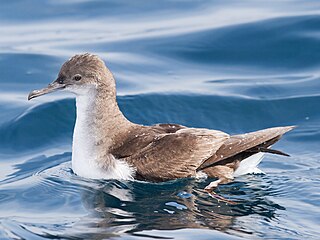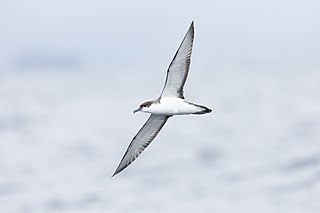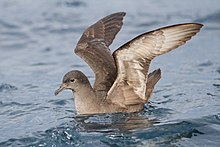
Shearwaters are medium-sized long-winged seabirds in the petrel family Procellariidae. They have a global marine distribution, but are most common in temperate and cold waters, and are pelagic outside the breeding season.

The family Procellariidae is a group of seabirds that comprises the fulmarine petrels, the gadfly petrels, the diving petrels, the prions, and the shearwaters. This family is part of the bird order Procellariiformes, which also includes the albatrosses and the storm petrels.

The great shearwater is a large shearwater in the seabird family Procellariidae. It breeds colonially on rocky islands in the south Atlantic. Outside the breeding season it ranges widely in the Atlantic.

The sooty shearwater, or tītī, or muttonbird, is a medium-large shearwater in the seabird family Procellariidae. In New Zealand, it is also known by its Māori name tītī, and as muttonbird, like its relatives the wedge-tailed shearwater and the Australian short-tailed shearwater.

The little shearwater is a small shearwater in the petrel family Procellariidae. Despite the generic name, it is unrelated to the puffins, which are auks, the only similarity being that they are both burrow-nesting seabirds.

Puffinus is a genus of seabirds in the order Procellariiformes that contains about 20 small to medium-sized shearwaters. Two other shearwater genera are named: Calonectris, which comprises three or four large shearwaters, and Ardenna with another seven species.

The Christmas shearwater or ʻaoʻū is a medium-sized shearwater of the tropical Central Pacific. It is a poorly known species due to its remote nesting habits, and it has not been extensively studied at sea either.

The wedge-tailed shearwater is a medium-large shearwater in the seabird family Procellariidae. It is one of the shearwater species that is sometimes referred to as a muttonbird, like the sooty shearwater of New Zealand and the short-tailed shearwater of Australia. It is found throughout the tropical Pacific and Indian Oceans, roughly between latitudes 35°N and 35°S. It breeds on the islands off Japan, on the Islas Revillagigedo, the Hawaiian Islands, the Seychelles, the Northern Mariana Islands, and off Eastern and Western Australia.

Audubon's shearwater is a common tropical seabird in the petrel family. Sometimes known as the dusky-backed shearwater, the specific epithet honours the French naturalist Félix Louis L'Herminier.
Muttonbird or mutton bird may refer to species of petrel, especially shearwaters, whose young are harvested for food and other uses before they fledge in Australia and New Zealand. The English term "muttonbird" originally emerged among settlers on Norfolk Island as the strong taste and fattiness of these birds' meat was likened to mutton. The Māori name for the birds, tītī, is also widely used in New Zealand.

The flesh-footed shearwater is a medium-sized shearwater. Its plumage is black. It has pale pinkish feet, and a pale bill with a distinct black tip. Together with the equally light-billed pink-footed shearwater, it forms the Hemipuffinus group, a superspecies which may or may not have an Atlantic relative in the great shearwater. These large shearwaters are among those that have been separated into the genus Ardenna. Recent genetic analysis indicates evidence of strong divergence between Pacific colonies relative to those in South and Western Australia, thought to be explained by philopatry and differences in foraging strategies during the breeding season.

Muttonbirding is the seasonal harvesting of the chicks of petrels, especially shearwater species, for food, oil and feathers by recreational or commercial hunters. Such hunting of petrels and other seabirds has occurred in various locations since prehistoric times, and there is evidence that many island populations have become extinct as a result. More recently ‘muttonbirding’ usually refers to the regulated and sustainable harvesting of shearwaters in Australia and New Zealand. These include the short-tailed shearwater, also known as the yolla or Australian muttonbird, in Bass Strait, Tasmania, as well as the sooty shearwater, also known as the titi or New Zealand muttonbird, on several small islands known as the Muttonbird Islands, scattered around Stewart Island in the far south of New Zealand.

Buller's shearwater is a Pacific species of seabird in the family Procellariidae; it is also known as the grey-backed shearwater or New Zealand shearwater. A member of the black-billed wedge-tailed Thyellodroma group, among the larger shearwaters of the genus Ardenna, it forms a superspecies with the wedge-tailed shearwater.

The pink-footed shearwater is a species of seabird. The bird is 48 cm (19 in) in length, with a 109 cm (43 in) wingspan. It is polymorphic, having both darker- and lighter-phase populations. Together with the equally light-billed flesh-footed shearwater, it forms the Hemipuffinus group, a superspecies that may or may not have an Atlantic relative in the great shearwater. These are large shearwaters which are among those that could be separated in the genus Ardenna.

Ardenna is a genus of seabirds in the family Procellariidae. These medium-sized shearwater species were formerly included in the genus Puffinus.


















